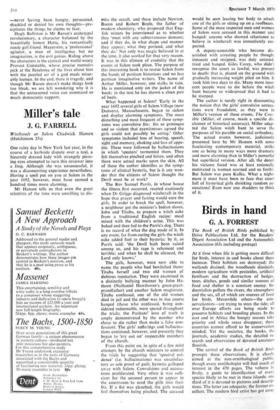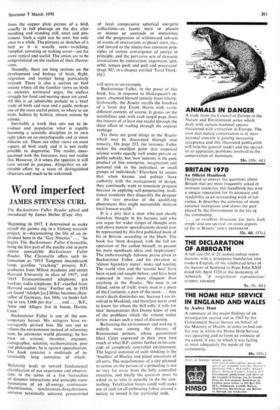Birds in hand
G. A. FORREST
The Book of British Birds published by Drive Publications Ltd, for the Readers' Digest Association Ltd and the Automobile Association (63s including postage)
At A- time when life is getting more difficult for birds, interest in and books about them increase. Their habitats are destroyed; the wetlands drained; the woodlands diminish: modern agriculture with pesticides, artificial fertilisers and the destruction of hedges. trees, ditches, ponds and similar sources of food and shelter is a constant enemy. In- dustrialists pollute the rivers, the atmosphere and the sea, all of which are sources of food for birds. Meanwhile others—the con- servationists—are trying to stem the tide; all over Europe efforts are being made to preserve habitats and breeding places. In the east and in Africa the hungry masses take priority and whole areas disappear; these countries cannot afford to be conservation minded. Yet the societies, the books, the journals, academic studies, the detailed re- search and observation of devoted amateurs flourish.
The arrival of the Book of British Birds prompts these observations. It is clearly aimed at the non-ornithological public. though every ornithologist will find much of interest in the 470 pages. The volume is, firstly, a guide to identification of every species likely to be met in these islands; one third of it is devoted to pictures and descrip- tions. The latter are adequate; the former ex- cellent. The modern bird artist has got away
from the copper plate picture of a bird, usually in full plumage on the day after moulting and standing still, erect and pro- minent. Such a sight can be seen, but only once in a while. The pictures or sketches of a bird as it is usually seen—twitching, rumpled, cowering or seeking cover—are far more typical and useful. The artists are to be congratulated on the realism of their illustra- tions.
Secondly, there are long sections on the development and biology of birds, flight, migration and instinct being particularly stressed. There is also a section on bird society where all the familiar views on birds as societies, territorial urges, the endless struggle for food and nesting space are aired. All this is an admirable prelude to a brief study of birds and man and a guide, perhaps one of the most useful points, to where to see birds, habitat by habitat, almost minute by minute.
Inevitably a work that sets out to in- troduce and popularise what is rapidly becoming a scientific discipline in its own right takes on an encyclopaedic and at times didactic air. There are other views on most aspects of bird study and it is not really possible to dogmatise. The reader, unac- quainted with the literature, may not realise this. However, if it whets the appetite, it will have served its purpose. Altogether an ad- mirable effort by a team of distinguished observers and much to be welcomed.



































 Previous page
Previous page